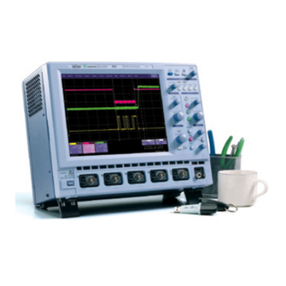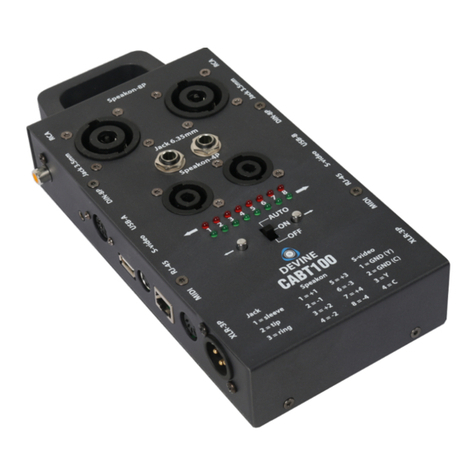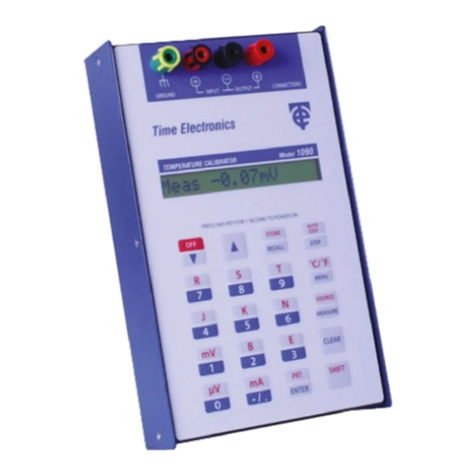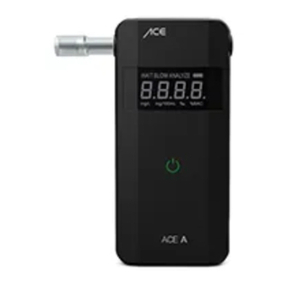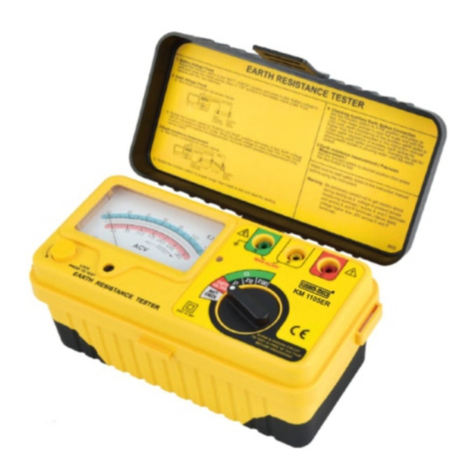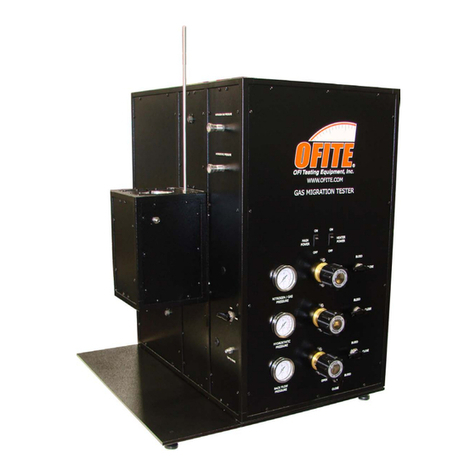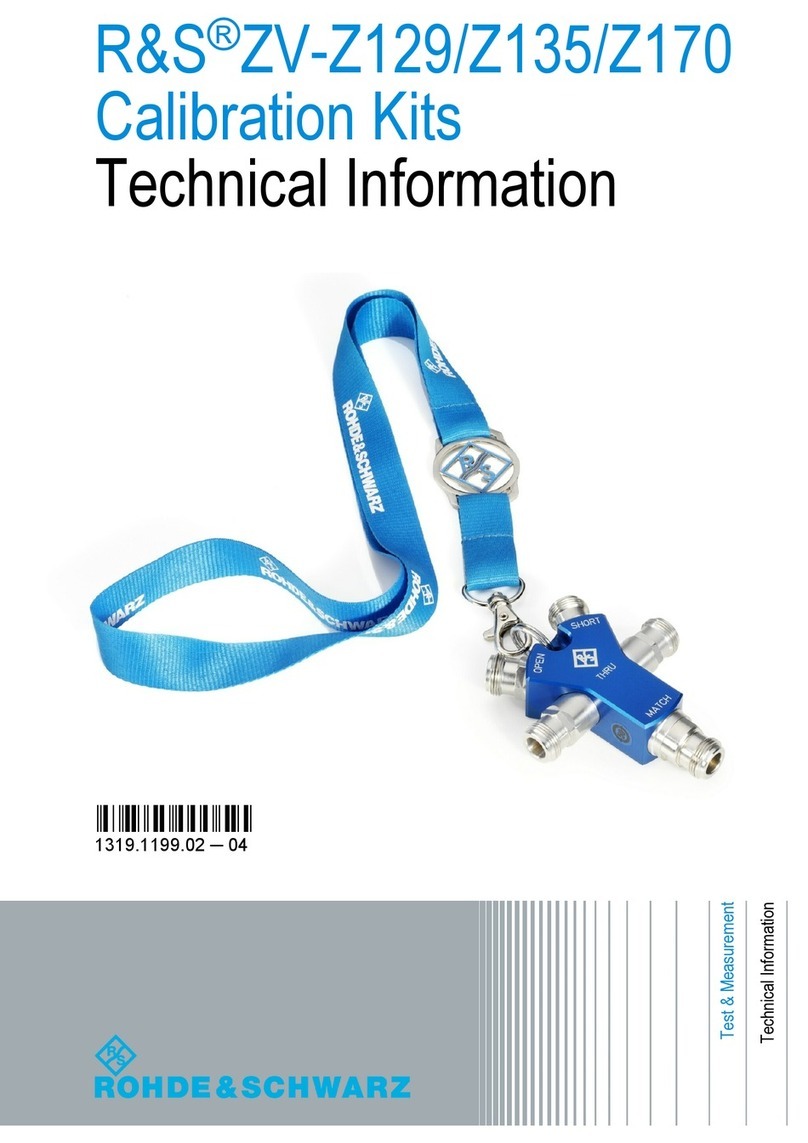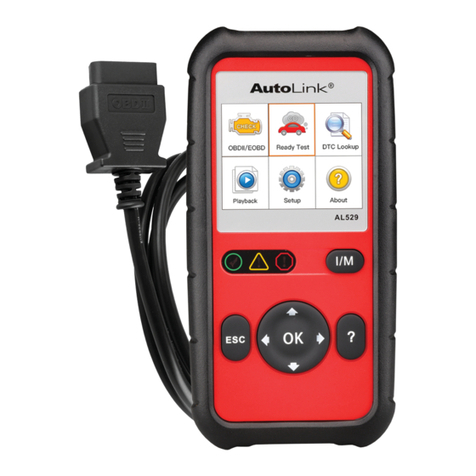CREATIVE ELECTRONICS ELT 1091 User manual

1
CREATIVE ELECTRONICS ELT 1091
OWNERS MANUAL
Creative Electronics, P.O. Box 2466, Orofino, ID. 83544,
Phone (208) 435-4002 Email
nas@cpcinternet.com

2
CONTENTS PAGE
QUICK START OPERATING INSTRUCTIONS 4
TESTING PROCEDURE EXPLAINED 5
INTRODUCTION TO 406 MHz BEACONS 6
UNIT DESCRIPTION
FEATURES 8
CONTROL FUNCTIONS 10
DISPLAY PAGES & ELEMENTS 11
HEX CODE DISPLAY 14
OPERATION 16
INTERPRETING ERROR MESSAGES AND TROUBLE SHOOTING 18
USING CONTINUOUS MODE TO FIND AN OPERATING 121.5 Mhz BEACON 18
TESTING
AVIATION ELTs AND BEACONS UTILIZING A TRIGGERING OR AUTOMATIC SWITCH 19
MARINE ELTs AND OTHER ELTs UTILIZING A MANUAL SWITCH OR OTHER METHODS 20
PERSONAL LOCATING BEACONS (PLB) 20
SPECIFICATIONS 22
APPENDIX
A. OPERATIONAL MESSAGES 24
B. ERROR MESSAGES 25
C. REGISTERING ELTS 28
D. COSPAS SARSAT SYSTEM 29

3
E. 406 TO 406.1 ELT OPERATION AND CHARACTERISTICS 30
F. 121.5 ELT OPERATION AND CHARACTERISTICS 32
G. BATTERY CONSIDERATIONS 33
H. RF SHIELDED CONTAINERS 34
I. FIELD STRENGTH MEASUREMENTS 41
J. TESTING LIMITATIONS 43

4
QUICK START OPERATING INSTRUCTIONS
1. Turn power on by selecting either POWER METER if using internal antenna
load, or FIELD STRENGTH if receiving from beacon’s own antenna
2. Toggle NEXT to make new tests, toggle PREVIOUS to review previously
saved tests
3. If POWER METER was selected, connect beacon to ANTENNA LOAD then
skip to step 4, if FIELD STRENGTH mode was selected, toggle NEXT to continue,
PREVIOUS to start continuous 121.5 mode.
4. Toggle NEXT to continue saving current series of tests, toggle PREVIOUS to
reset memory and then start a new series of tests.
5. Using the toggle, select the operating frequency of the beacon if known
following the display prompts, if unknown, select the default UNKNOWN.
. If frequency selection is correct, toggle NEXT to continue, PREVIOUS to
return to selection display and redo
8. The READY message should be displayed along with the battery condition
and the tester is armed to receive and test a signal
9. Activate beacon
10. Observe the results. GREEN LED = OK, RED LED = ERROR. Use the toggle to
select the various displays showing either error messages if any, or the measured
results eventually toggling back to the READY message page
NOTE: IT IS IMPORTANT TO COMPARE THE DISPLAYED HEX CODE WITH THE ONE
ASSIGNED TO THE BEACON AND THE COUNTRY DISPLAYED WITH THE COUNTRY
THE BEACON IS REGISTERED TO. SEE PAGES 12 AND 14. IF DIFFERENT, THE
BEACON IS DEFECTIVE.

5
TESTING PROCEDURE EXPLAINED
The 406 Mhz. emergency beacon system, unlike the previous simple system, has
many features designed to enhance reliability and reduce search times. As such,
it sends a more complicated signal and is therefore important that all aspects of
its signal are tested and verified. There are 2 basic types of tests, RF power
output from the beacon (power meter), and the amount of power being radiated
from the antenna (field strength) and permitting both should be accomplished.
The POWER METER mode of testing is an off the air test and requires at least 3
transmissions from the beacon
to complete. This is an actual operational test of
the beacon that checks all aspects of the signal it is sending. This method is only
possible on beacons that use an external antenna giving direct access to the
transmitter typically aviation ELTs, and some marine beacons
The other is an on the air test, FIELD STRENGTH, of the beacon and uses the test
mode function required for all beacons. The test function is identified as such to
the COSPAS SARSAT system so that it will not trigger a search, but as such not all
aspects of the beacon are tested. Instead of measuring the power output of the
beacon, this test measures the strength of the RF field the beacon and its antenna
are producing. This is a product of not only the amount of power generated by
the beacon but also the efficiency of the antenna system.
Unless you want to initiate a search, DO NOT OPERATIONALLY ACTIVATE A
BEACON WHILE CONNECTED TO AN ANTENNA. After the second transmission, it
will set off an alarm and start a search. The Creative Electronics tester includes an
ANTENNA LOAD to replace the beacon antenna when testing the beacon and is
also used in the POWER METER mode to measure the actual power the beacon is
producing. When running this test, the beacon should be placed in a RF shielded
container to prevent accidental radiation of a signal that the system could
receive, since a plastic enclosure will not shield the signal and the cables used to
connect the tester to the beacon need to be double shielded cables.

6
INTRODUCTION TO 406 MHz BEACONS
Currently there are several types of Emergency locating transmitters or beacons. One of which
is the earlier 121.5 MHz type and another, the newer 406 MHz to 406.1 MHz type. The earlier
type transmits a continuous amplitude modulated signal without any information and relied on
persons who heard it to use direction finders to locate the source. While better than nothing,
the system was prone to many false alarms, and significant delays until the signal was first
discovered. The newer system resolved these problems by incorporating an identifying
message in the transmission along with optional location information and a system of orbiting
satellites that continuously monitor the 406 to 406.1 MHz band and relay the signals back to
Earth command centers.
There are two basic messages each having many variations tailored to suit the application using
the beacon. One is the short message (440 mS) which has no location information. The other is
the long message (520 mS) which can include location information. A portion of both messages
contain the following basic information; the protocol being used, the identity of the beacon, its
country of registration, and if it is a normal actual alarm or a test signal. If it is the long
message, also included is the last location, within a limited time frame, when the beacon was
activated.
Some additional requirements are to be met. When the beacon is activated for an actual alarm,
there is a brief delay prior to the first actual transmission. This is to allow the beacon to be
deactivated if the activation was inadvertent. Then once the transmission starts, the first 160
mS are to be un-modulated, in other words no data is sent. This is followed by a short
synchronizing signal which is then followed by the message sent in a specialized digital format
that contains the information needed to help identify and locate the beacon. This transmission
is supposed to be made at approximately 50 second intervals which are to be random in nature
so as to minimize any two beacons from continuously interfering with each other. There are
other features of the system which have been well thought out and implemented; the details of
which can be found in the specifications for the system from the Cospas Sarsat web site.

UNIT DESCRIPTION
The Creative Electronics model ELT 1091A ELT tester was designed for use by aviation
maintenance technicians and others who have the need to routinely test ELTs and PLBs to
determine that they will work properly when called on to do so. As such it was not designed to
be used as a laboratory test instrument to obtain the original certification of such devices. The
tester will however determine if the ELT/PLB is working properly, and decode and display the
message it is sending. The tester has been designed to be simple and intuitive to use and
provide a thorough test of the ELT/PLB and supply a simple go / no go indication along with the
message information generated by the ELT/PLB. It is up to the user of the tester to make sure
that the sent HEX code and country of registration are correct. (SEE PAGES 12 & 14)
The tester consists of two receivers, one for 121.5 Mhz. and the other for 406.0 to 406.1 Mhz.,
a dedicated MCU, a clock timing reference source, an 80 character display, 4 bicolor LED’s, an
audio amplifier with speaker and a substitute 50 ohm antenna load.
The ELT 1091A tester incorporates a power switch which is used to determine which of the two
operating modes is desired, POWER METER or FIELD STRENGTH. The other switch, a spring
loaded center off toggle switch is primarily used to cycle thru the various display pages as well
as control several other functions to be described later. The results of the various tests are
provided by 3 red/green LEDs and the 80 character LCD display arranged with 4 lines of 20
characters each.
Power is supplied by 8 AA batteries. A special monitoring circuit turns the tester off if there is
no activity for 15 minutes to conserve the batteries. If the battery voltage gets below a level
that will affect the accuracy of the tester, the BATTERY LED will turn red, and the display will
display a message to replace the batteries, and the tester will become disabled. An additional
circuit monitors the internal temperature of the tester and will disable the tester if the
temperature is out of the normal operating range that would affect the accuracy of the tester.
The display will display either a temperature too high or too low message. The tester will
remain disabled until the internal temperature is returned to the normal operating range.

8
FEATURES
Simple to use
Tests all 121.5 Mhz. and all 406 to 406.1 Mhz. ELTs and PLBs
Decodes and displays the message
15 minute inactivity shutdown to conserve the batteries
Internal 50 ohm antenna load for power measurements
Measures RF power output
Measures relative RF radiated field strength
Pass / fail red or green LED indication of test results
80 character display (4 lines of 20 characters).
Displays protocol, format, message, and test measurement values
Measures for 121.5 Mhz.
Frequency
Modulation
Power or field strength
Measures for 406 Mhz.
Frequency
Modulation
Power or field strength
Transmitter output stability
Transmission time
Transmission recycling time
Data clocking rate
Un-modulated time

9
Decodes and displays
Short message
Long message
15 digit hex code
ELT / PLB type
Marine protocols
Aviation protocols
User protocols
Standard protocols
National standard protocols
PLB protocols
Country codes (displays country)
Location protocols
Operating mode (normal or test)
Aux ELT data
Unit 15 hex identification
Stores the previous test results for later viewing
Utilizes a dedicated imbedded MCU not dependent on WINDOWS ™or any other operating
system
Includes an amplifier with a speaker to aurally monitor the received signal

10
CONTROL FUNCTIONS
POWER SWITCH
Power meter mode
Measures the RF power of both the 121.5 Mhz. or the 406 Mhz. to 406.1 Mhz.
transmitters
Field strength mode
Measures the relative RF field strength being radiated from the antenna for both
the 121.5 Mhz. and 406 Mhz. to 406.1 Mhz. transmitters
FUNCTION SWITCH
On startup
Selects new tests or review previous tests
Selects either continuous 121.5 Mhz. field strength mode or 121.5 and 406 – 406.1
normal mode
Selects to continue test group, or clean memory of previous test results
Used to select the operating frequency of the 406 Mhz. to 406.1 Mhz. ELT
On receiving a signal on 121.5 Mhz.
In continuous field strength mode, selects numeric or bar graph display mode
In normal mode toggles display between the status page, measurements page, and
Field strength ready page.
In field strength mode while receiving a signal on 121.5 with the ready page displayed,
will mute or unmute the 121.5 audio
On receiving a signal on 406 Mhz. to 406.1 Mhz.
Toggles display between the following in order
Identification / location page

11
Errors page if any errors occurred
or
Values page with or without errors
Timing page
Ready page
DISPLAY PAGES & ELEMENTS
OPENING PAGE
Displays Source code name, version number and serial number. Prompts to start
new tests or review previous tests.
FIELD STRENGTH OPTION PAGE
Prompts for continuous 121.5 field strength or normal mode
CONTINUOUS MODE PAGE
Prompts for numeric or bar graph presentation
MEMORY CONTROL PAGE
Prompts to continue a group of test results, or clean the memory of previous test
results
FREQUENCY SELECTION PAGE
Prompts for selection of a frequency in the 406 Mhz. to 406.1 Mhz. band
FREQUENCY VERIFICATION PAGE
Display the selected frequency and prompts to accept or reselect a different
frequency
READY PAGE
Indicates that the tester is armed and ready to receive a signal and displays current
memory available and battery state

12
121.5 STATUS PAGE
Displays the pass or fail status of each measurement
121.5 MEASUREMENTS PAGE
Displays the measured values of the
Frequency
Percent of modulation
Power in mlliwatts in the power mode
Relative field strength in mV at the receiver input in the field strength mode
406 MESSAGE PAGE
LINE 1
Type of beacon
Identification format
Aircraft nationality and registration markings
Maritime user (MMSI or RADIO CALL SIGN)
Radio call sign user
Serial user protocol (ELTs, PLBs, EPIRBs)
Aircraft 24 bit address
Aircraft operator, Serial number
COSPAS-SARAST TA No, Serial number (SHOWN)
MMSI (Last 6 digits, binary)

13
Protocol
U = User
S = Standard (SHOWN)
N = National
Type of operation
T = Test (SHOWN)
N = Normal
Source of location data
I = Internal (SHOWN)
E = External
LINE 2
Unit identification
Type of auxiliary beacon installed if any
LINE 3
Location information if available
LINE 4
Country of registration NOTE: IT IS IMPORTANT TO COMPARE THIS WITH THE
ACTUAL REGISTERED COUNTRY

14
406 VALUES PAGE
LINE 1
15 digit hex code NOTE: IT IS IMPORTANT TO COMPARE THIS WITH THE HEX
CODE ASSIGNED TO THE BEACON BEING TESTED
LINE 2
Measured frequency
LINE 3
Un-Modulation time
Modulation percentage
LINE 4
Data clock rate
Power in watts in power mode
or
Field strength in mV in field strength mode

15
406 TIMING PAGE
LINE 1
Length of transmission
LINE 2
Previous recycle time
LINE 3
Current recycle time
LINE 4
Recycle time variation or difference
406 Errors display
LINEs 1 thru 4 display any errors that were found and lists what they were. If more
than 4 errors were encountered the 4
th
line will display “MORE” and toggling the FUNCTION
SWITCH “NEXT” will display the additional items if any or to the 406 values screen.
BATTERY LOW PAGE
Prompts to replace batteries
TEMPERATURE LIMITS PAGE
Identifies temperature out of limits condition
INSUFFICIENT SIGNAL PAGE
Warns of a signal that is not strong enough to allow reliable measurements

16
OPERATION
INITIAL TURN ON
The POWER toggle switch has three positions, the center position is OFF, up
selects the “FIELD STRENGTH” mode of operation, and down selects the “POWER METER”
mode of operation.
FIELD STRENGTH MODE
In the FIELD STRENGTH mode, the tester receives its signal off the air from the beacon’s
transmitting antenna or radiating source. If the “FIELD STRENGTH” mode has been selected, a
message will be displayed prompting you to select either the “CONTINUOUS 121.5” field
strength mode, “PREVIOUS”, on the function switch, or “TO CONTINUE”, “NEXT”, on the
function switch. If the “CONTINUOUS” mode was selected, the tester will continuously monitor
the 121.5 Mhz. and continuously display the results using either a numeric value or bar graph
presentation. This mode is helpful in determining the radiation pattern of a transmitting
antenna on 121.5 Mhz. or in identifying the source of an active 121.5 beacon. While in the
continuous 121.5 mode, the toggle can be used to select between the numeric or bar graph
display (PREVIOUS) or to exit the continuous mode (NEXT). The continuous mode is not useable
for the 406 Mhz. signals because of the intermittent nature of the 406 Mhz. transmissions, and
is not practical or available. However, the beacon sends an identifying code that the tester will
display and can be used to identify the source of the signal.
With the normal FIELD STRENGTH mode selected, when the tester receives a signal on 121.5
Mhz. it measures the frequency, modulation, and relative field strength. Once the
measurements have been completed, the display will indicate the status of each measurement
as either “OK” or if incorrect for example “Modulation low”, and illuminate the 121.5 LED either
GREEN for ok, or RED for defective. If the FUNCTION SWITCH is toggled to “NEXT”, the display
will switch to the 121.5 Mhz. values page and display the actual measured values of the
received signal on 121.5 Mhz. Now toggling the FUNCTION SWITCH to “NEXT” will return the
display to the ready page, while toggling to “PREVIOUS” will return to the status page. Once
the 121.5 Mhz. portion of the ELT has been tested, even though it may still be running, or be of
an intermittent transmission type, the tester will ignore it until the tester is reset.
If the 121.5 Mhz. ELT is running and you desire to mute out the audio, once the test has been
completed, and the ready page is being displayed, toggling the FUNCTION SWITCH, while
receiving a signal on 121.5 Mhz, to “PREVIOUS” (down) will mute the 121.5 Mhz. audio, toggling

1
to “NEXT” (up) will activate the 121.5 Mhz. audio. The 406 Mhz. to 406.1 Mhz. audio is not
affected with this switch feature.
While in the normal mode, the 406 / 406.1 receiver continuously remains active and as soon as
a signal is received it is processed. Once processed the first 406 / 406.1 page, the MESSAGE
page, will appear and if no errors occurred the appropriate LED (long or short) will illuminate
green. If there were errors, the appropriate LED will illuminate red. Toggling “NEXT” will then
change to the ERROR page if there were any errors, or the 406 / 406.1 VALUES page if no errors
occurred. Further toggling of the function switch to NEXT will then display the 406 / 406.1
TIMING page, toggling to PREVIOUS will cause the previous screen to display, either the ERROR
page if errors were present, or the MESSAGE page if no errors were present.
POWER METER MODE
When selecting the POWER METER mode, the tester functions the same as if in the one shot
FIELD STRENGTH mode except it will measure the amount of RF power being applied to the
built in ANTENNA LOAD located on the side of the tester. If the ELT is not connected to the
ANTENNA LOAD, the tester will still receive it, however an error will occur, and no power will be
indicated.
If in the FIELD STRENGTH mode, and the ELT is connected to the “ANTENNA LOAD” and a
transmission is made, the “SHORT” and “LONG” LEDs will flash alternately and a message will
display to warn that the ELT should be connected to its antenna or the tester switched to the
“POWER METER” mode.
REVIEW OF PREVIOUS TEST RESULTS
This mode can only be entered when the tester is first turned on. After the opening page, a
page will display allowing you to continue making tests, or to view previous tests. Use the
FUNCTION switch to make your selection. Once in the review mode, you may toggle between
the saved pages which have been stored in the order that they occurred. The lights will
correspond to the displayed page. To delete the saved pages (all), another screen will prompt
you to either continue with a series of tests, or to start a new series of test. If you toggle
previous, the memory will be cleaned off of all the previous tests, while toggling next will add
the next tests to those already stored in the memory. Once the memory is full when the tester
is turned on, it will automatically reset the memory prior to starting a new series of tests,
removing all previously stored test results.

18
INTERPRETING ERROR MESSAGES AND TROUBLE SHOOTING
While most beacon failures are caused by a single problem and will be evident as such, some
failures can cause multiple error indications. For example an unstable transmitter may also
result in a modulation error, and/or an incorrect frequency error, along with a garbled message
and incorrect hex id or location information. Some errors can also be created by incorrect
usage of the tester, as for example by placing the tester too close to the antenna causing the
tester to become overloaded resulting in incorrect measurements and errors. In this case,
relocate the tester further away and retry the test. If a marginal signal error occurs, try moving
the tester closer to the antenna. However, if the distance is closer than normal to get a valid
signal, assuming that the power test was normal, the antenna system is suspect.
USING CONTINUOUS MODE TO FIND AN OPERATING BEACON
The ELT1091A tester incorporates a CONTINUOUS MODE of operation which can be used to
check the radiation pattern of a 121.5 Mhz. antenna installation or to identify the location of a
nearby operating beacon on 121.5 Mhz. The CONTINUOUS MODE can be activated after the
tester is turned on in the field strength mode by toggling the function switch to NEXT (up), and
then to PREVIOUS (down). Subsequent toggling of the function switch (down) will select
between a numeric or bar presentation of the signals strength. Toggling to NEXT will exit the
CONTINUOUS MODE and place the tester in the one shot mode. While either the numeric or
bar presentation will work, the bar presentation is better suited for locating the source of a
beacon. The receivers of the tester are intentionally of low sensitivity to provide a better
indication of a beacons performance. As a result, when trying to locate the source of a
beacon’s signal, for example in a large hangar, it will likely be necessary to move around to the
various possible sources to find the one that provides the strongest or highest reading.

19
RECOMMENDED TESTING PROCEDURES
AVIATION
STEP PROCEDURE
1. REMOVE ELT FROM AIRCRAFT
2. CONNECT TO ANTENNA LOAD USING A HIGH QUALITY CABLE
3. SET TESTER TO POWER METER
4. SELECT TRANSMITTER FREQUENCY IF KNOWN, OTHERWISE “UNKNOWN”
5. ACTIVATE ELT BEACON USING IMPACT SENSOR
6. PLACE ELT INTO A SHIELDED CONTAINER TO PREVENT UNAUTHORIZED RADIATION
. ALLOW ELT TO CYCLE A MINIMUM OF 3 TIMES
8. MONITOR AND NOTE RESULTS AND CHECK THE HEX CODE AND COUNTRY OF
REGISTRATION
9. REMOVE ELT FROM SHIELDED BOX AND RESET
10. REINSTALL ELT IN AIRCRAFT AND RECONNECT TO ANTENNA
11. RESET TESTER TO FIELD STRENGTH
12. PLACE TESTER A CALIBRATED DISTANCE (APPROX 10 FEET) FROM THE ELT ANTENNA
13. RE-ACTIVATE ELT IN THE SELF TEST MODE USING THE AIRCRAFT FRONT PANEL
CONTROL
14. WAIT A MAXIMUM OF 1 MINUTE FOR ELT TO FUNCTION
15. MONITOR AND NOTE RESULTS
16. RESET ELT AND ARM
1 . CHECK BATTERY LIFE
18. MAKE LOG BOOK ENTRY
NOTES:
UPON THE COMPLETION OF A TEST, MAKE SURE THE HEX ID CODE SENT MATCHES THE
CODE ASSIGNED TO THE BEACON AND THAT THE COUNTRY IS CONSISTENT WITH THE
REGISTRATION COUNTRY OF THE BEACON, (SEE PAGES 12 & 14) AND THE BEACON IS
INSTALLED IN THE CORRECT AIRCRAFT AND ARMED.
Aviation ELTs are made with plastic cases which result in a significant amount of
radiated signal even when not connected to an external antenna, enough to be received by the
satellite system. As a result when testing these devices, it is important to place the ELT in a
metal shielded container (see appendix) shortly after being activated to prevent inadvertently
setting off a search alarm. Once the frequency, RF power, modulation, timing parameters, and
recycle times have been checked, and once reinstalled in the aircraft, The ELT is supposed to be

20
able to send one test transmission utilizing the test function. This transmission is marked as a
test transmission and disregarded by the satellite system. The tester will also recognize that it
is a test transmission and will display a “T” on the top line of the message page on the right
side. If an “N” appears here, the ELT is defective as it transmitted a normal transmission which
could set off an alarm. When initially activated in the normal (alarm) mode, COSPAS-SARSAT
requires an approximate 50 second delay from the time of activation until the first actual
transmission by the beacon is made. This should provide sufficient time to turn off an
accidently activated beacon or place the beacon in a shielded container for testing.
MARINE
Marine ELTs come in several types. Some are manually activated, while others are
automatically activated by one or more of several different methods. When testing the manual
or automatic activation methods, prior to activating the ELT, make sure that you can reset it
once activated. Additionally some use a removable antenna with a standard connector while
others utilize an integral antenna which has no provision for directly testing the RF power being
generated by the ELT. Therefore the procedure used to test the ELT can be a variation of the
AVIATION procedure or the PLB procedure and will have to be determined by the individual
making the tests. In any event, care should be taken to not radiate any normal (not test) signals.
NOTE: CHECK THE HEX CODE AND COUNTRY OF REGISTRATION, SEE PAGES 12 & 14
PLB
PLBs present a different problem in testing them since they are self-contained having an
integral antenna and therefore no way to test the actual RF power being generated.
Additionally, if activated in the normal mode of operation (not test) they will most definitely
trigger an alarm unless placed in a suitable shielded container (SEE APPENDIX G). As with some
Marine ELTs, it is important to be sure that you can reset the PLB once activated in the normal
mode for testing.
RECOMMENDED PROCEDURE
STEP PROCEDURE
1. Set tester to field strength
2. Place the PLB approximately 6 inches from the tester
3. Activate PLB in test mode
4. Note results.
5. Check HEX code and country of registration (SEE PAGES 12 & 14)
Table of contents
Popular Test Equipment manuals by other brands

Zehntner
Zehntner ZSH 2290 instruction manual
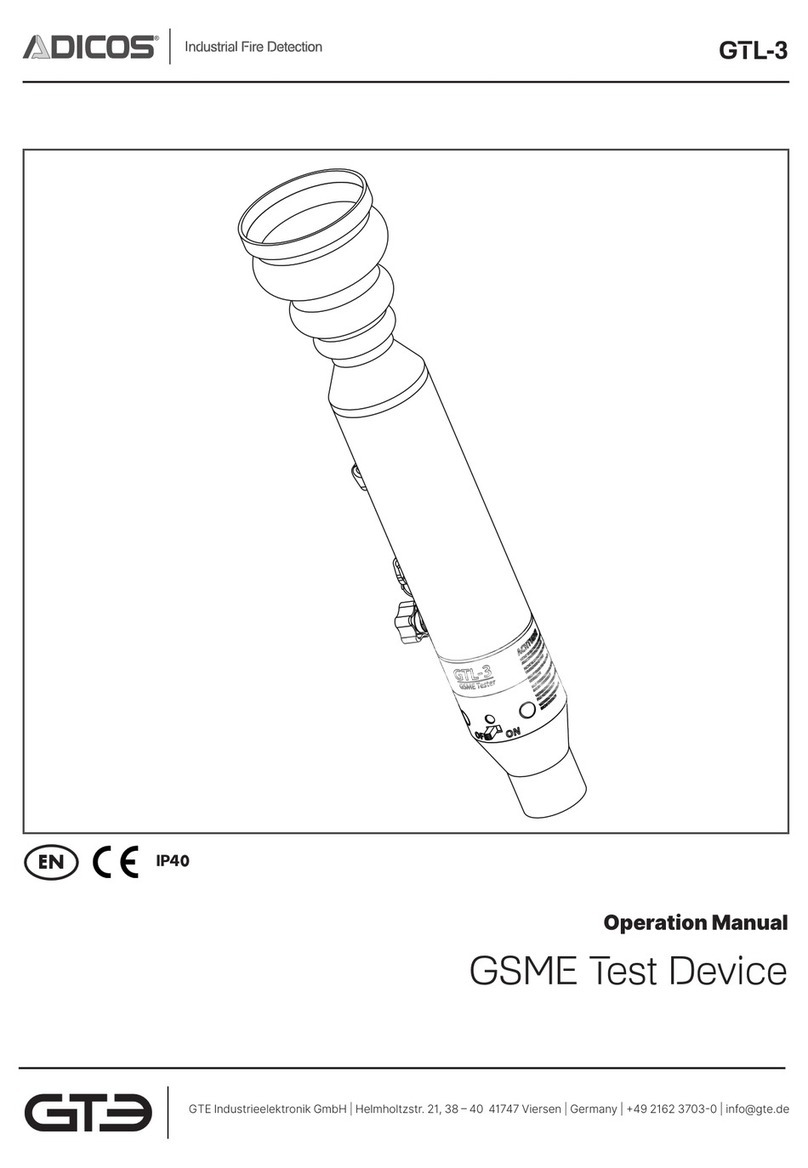
GTE
GTE Adicos GTL-3 Operation manual

MULTI MEASURING INSTRUMENTS
MULTI MEASURING INSTRUMENTS MCL-800D+ instruction manual

Kenwood
Kenwood CO-1506 instruction manual

Agilent Technologies
Agilent Technologies InfiniiVision 6000 Series user guide
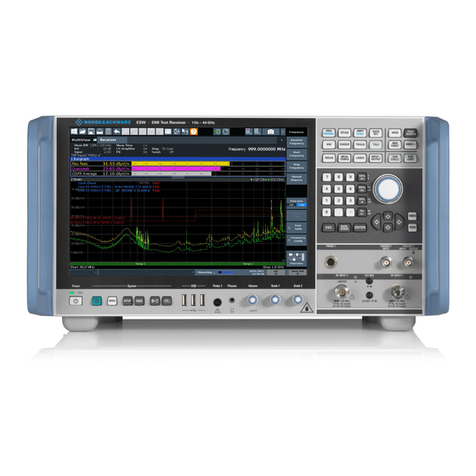
Rohde & Schwarz
Rohde & Schwarz ESW user manual
